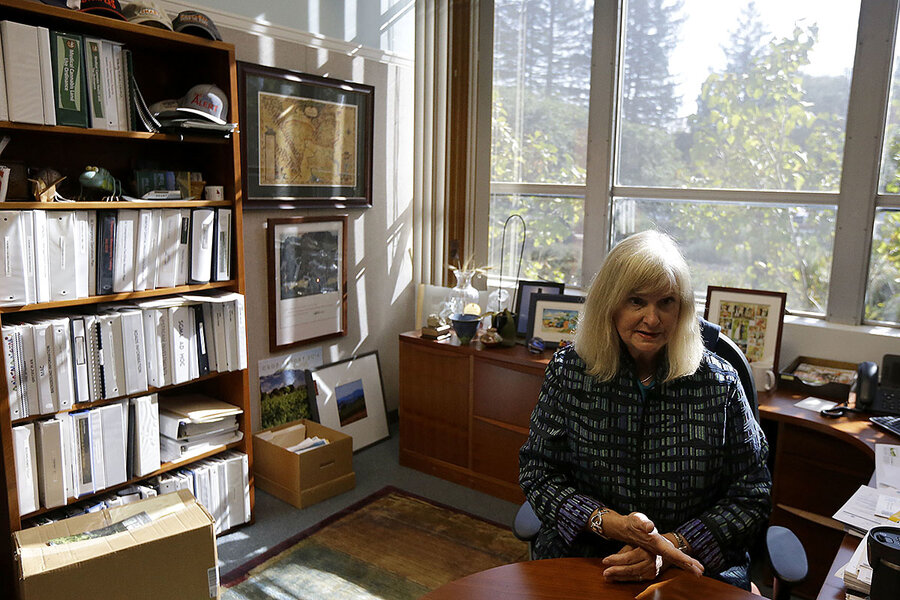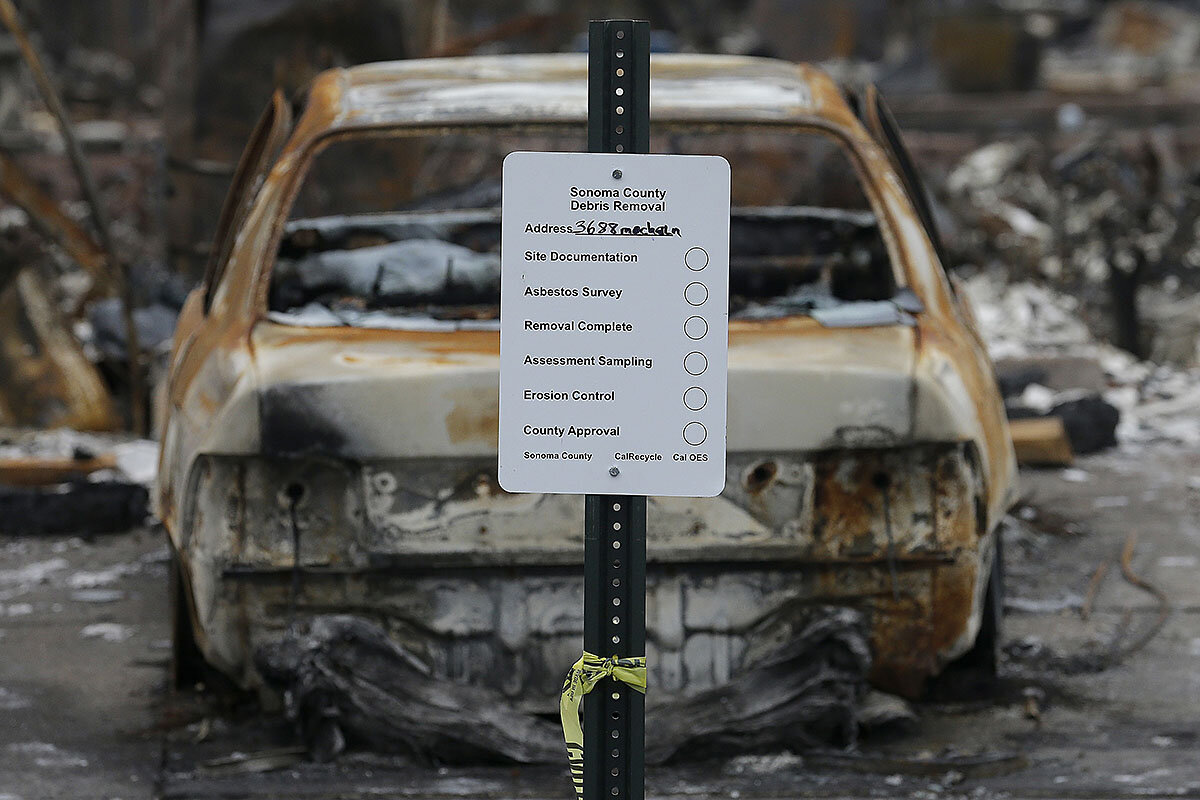With rents soaring after fires, can Santa Rosa make room for middle class?
Loading...
| Los Angeles
More than a month after the Tubbs fire burned down his house, Vincent Larsen has yet to find a new home.
As soon as they could, he and his fianceé applied to a series of rentals in Santa Rosa, Calif. – nearly 15 in the past two weeks alone, he says. But competition is fierce. “Everywhere we went there were already eight other people looking at the place,” says Mr. Larsen, an electrician who supplements his income by doing odd jobs.
Because he didn’t have renters insurance, Larsen – who makes about $40,000 a year – lacks the benefit of having an insurance company offer landlords exorbitant rental rates of up to $13,000 a month to put him at the front of the line. Meanwhile he’s living with his fianceé and her 8-year-old daughter at her mother’s house, trying to keep up with the costs of restarting their lives.
“It’s hard right now,” Larsen says.
The series of wildfires that engulfed more than a million acres in Northern California in early October was among the deadliest in state history, killing 42 people and incinerating some 8,400 structures. Preliminary losses are estimated at more than $1 billion. The largest inferno, the Tubbs fire, destroyed 3,000 homes – about 5 percent of the housing stock – in Santa Rosa alone, squeezing an already strained housing market and leaving residents like Larsen with limited options.
With tragedy, however, comes opportunity. Before the fire, the area was being divided by a rapidly growing income gap. The disaster exposed the cracks in the community’s infrastructure and social services and spurred residents to support one another. And it has pushed officials and advocates to consider rebuilding in a way that accounts for the challenges that faced the region pre-fire – as well as the lessons they’re learning about living in a fire-prone area.
“This has been a real learning curve for us in city government who have never seen a disaster like this, ever,” says Santa Rosa Mayor Chris Coursey. “It’s added to our resolve to keep moving forward with our pre-fire housing plans and to deal with this disaster at the same time.”
A search for creative solutions
The post-fire series of ordinances adopted by both Santa Rosa and Sonoma County, which had a 3 percent vacancy rate before the fire, are meant to make it easier for residents to stay in the area as they look for new housing or make plans to rebuild. Under the new measures, homeowners can rent out accessory dwelling units to displaced residents and get fees for building such units waived or reduced. Residents can also park their RVs, trailers, and other vehicles overnight on approved areas where local and state agencies provide services like showers and warming stations.
Officials are also trying to think more creatively about how to rebuild. Santa Rosa, for instance, is looking to partner with Sonoma Clean Power – the city’s main electricity provider – to help residents rebuild structures that would meet the state’s 2020 standards for energy efficiency, Mayor Coursey says. “We can have a swath of our community be net-zero energy consumers when this is done,” he says. The city is also hoping to get support from the US Department of Housing and Urban Development (HUD) to construct permanent housing on emergency sites, the mayor says.
At the county level, Permit Sonoma – in charge of processing resident applications to rebuild in the county’s unincorporated areas – plans to create a new center solely to serve fire survivors. A housing task force, made up of local, state, and federal representatives, has also been appointed to come up with ways to cut down costs for long-term urban development.
“Everything’s on the table, and everyone’s thinking about creative solutions to develop more housing,” says Maggie Fleming, a communications manager for the county.
The new policies largely align with what researchers say are best practices for short- and long-term responses to disasters.
Who pays?
Some lawmakers are calling out the federal government for its lack of support. On Friday, the White House requested from Congress $44 billion in supplemental disaster aid – none of which is meant to help California recover from the wildfires. “Folks throughout California were ravaged by this fire, and we should ensure they get the help and support they need,” Rep. Mike Thompson (D) of Napa Valley told the Los Angeles Times on Sunday.
And not everyone is immediately benefiting. Since losing the two-bedroom house he and his family were renting in Santa Rosa’s Fountaingrove neighborhood, Larsen has struggled to secure any kind of aid from nonprofit or government agencies. He’s in a dispute with his former landlady over his security deposit. And he says that since the fires, he’s spent close to $6,000 in clothes, shoes, food, and other necessities for himself, his fianceé – a full-time nursing student – and her daughter.
“When you have nothing, you’ve got to buy,” Larsen says. “It’s such a vulnerable and fluid situation.”
What keeps Larsen going, besides his family, is the community. Days after he and his family evacuated, an uncle who lives in the area set up a PayPal account to receive donations on their behalf. Larsen has pitched in to help others, helping to hook up houses with generators when the power was out and put out spot fires across his old neighborhood.
“People have been doing fundraising, really giving back,” he says. “They’ve been dynamite.”
Bill Gittins, an artist who also lost his home in the fires, says the spirit in Santa Rosa today reminds him of what it was like when he and his wife first moved to the city in 1973. Strangers are stopping each other on the street, wishing each other well. There’s a renewed sense of community that he says was almost lost as the city grew and progressed. “It’s kind of a renaissance,” he says.
Both Larsen and Mr. Gittins say that their losses have reinforced their values and led them to reevaluate their priorities. “It’s definitely an opportunity to do things differently. And to do things better,” Gittins says.
Others apply the sentiment to a broader frame.
“The wildfires have put our community in a position to start a conversation to solve this crisis and provide affordable housing for all of our residents – both those displaced by the fires and those who were experiencing homelessness and displacement before the fires,” says Shelby Harris, a Santa Rosa native who works with Social Advocates for Youth, a nonprofit that serves homeless youth in Sonoma County. “There are a lot of people here who care about the community.”







